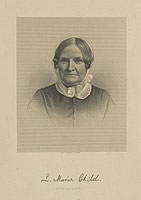![]()
Lydia Maria Child. Engraving.
![]()
Lydia Maria Child
![]()
Novelist, scholar, and activist for women’s rights, Lydia Maria
Child (1802-1880) became an abolitionist after she began reading Garrison’s
news journal, The Liberator. In 1833, Child wrote “An Appeal
to that Class of Americans Called Africans,” an anti-slavery tract
in which she declared her willingness to battle for emancipation. Her
new abolitionist rhetoric so repelled readers that Child's books sold
poorly, and she could not find a publisher willing to accept her work.
From 1841-43, Child was the editor of the National Anti-Slavery Standard,
the American Anti-Slavery Society’s newspaper. She later resigned
because of infighting among the society's members, who were divided in
their support for the diverging philosophies, “moral suasion”
and political persuasion. Child revitalized her role as an opponent of
slavery after the passage of the Fugitive Slave Law in 1850 and John Brown’s
raid on Harper’s Ferry in 1859. She continued publishing letters,
edited Harriet Jacob’s Incidents in the Life of a Slave Girl,
and wrote primers and anti-slavery tracts to combat racial injustice.
![]()
- William Lloyd Garrison
- Wendell Phillips
- Lydia Maria Child
- Samuel J. May
- Lucretia Mott
- Sojourner Truth
- Lewis Tappan
- William Seward
- Frederick Douglass
- Gerrit Smith
- Pennsylvania Hall
| |
| |
| |
| |
| |
| |
| |
| |
| |
| |
| |
| |

Copyright © 2002 Division
of Rare & Manuscript Collections
2B Carl A. Kroch Library, Cornell University, Ithaca, NY, 14853
Phone Number: (607) 255-3530. Fax Number: (607) 255-9524
For reference questions, send mail to:
rareref@cornell.edu
For questions or comments about the site, send mail to: webmaster.
